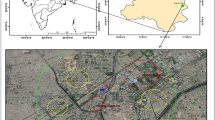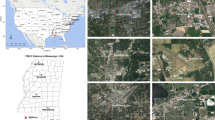Abstract
The variability of PM2.5 concentrations obtained from the air quality monitoring stations (AQMS) established at six different environments of the Pune Metropolitan Region (PMR), situated in the western part of India, is analyzed for the period 2014–2018. The PM2.5 concentrations showed an increasing trend at almost all locations within the city during the 5 years. Significant features observed were that the green/background location showed a declining trend in PM2.5 concentrations. However, the city's industrial area indicated an increase in PM2.5 concentrations over the years. The seasonal bivariate plot of PM2.5 showed that the winter season has the highest concentration, and also at low wind speeds a high concentration was observed, indicative of the local sources. Concentrated weighted trajectory analysis indicated that regional sources due to long-range transport also played a role in the PM2.5 mass concentration. The wavelet power spectrum of PM2.5 showed 2–4 day oscillations and 30–50 day oscillations associated with Madden-Julian oscillations.






Similar content being viewed by others
Data Availability
Data can be made available on request.
References
Anand, V., Korhale, N., Rathod, A., & Beig, G. (2019). On processes controlling fine particulate matters in four Indian megacities. Environmental Pollution. https://doi.org/10.1016/j.envpol.2019.113026
Beegum, S. N., Moorthy, K. K., Babu, S. S., Reddy, R., & Gopal, K. R. (2009). Large scale modulations of spectral aerosol optical depths by atmospheric planetary waves. Geophysical Research Letters, 36, 1–5. https://doi.org/10.1029/2008GL036509
Beig, G., Chate, D. M., Sahu, S. K., Parkhi, N. S., Srinivas, R., Ali, K., Ghude, S. D., Yadav, S., & Trimbake, H. K. (2015). System of Air Quality Forecasting and Research (SAFAR- INDIA). GAW Report No. 217. World Meteorological Organization Global Atmosphere Watch.
Beig, G., Sahu, S. K., Anand, V., Bano, S., Maji, S., Rathod, A., Korhale, N., Sobhana, S. B., Parkhi, N., Mangaraj, P., Srinivas, R., Peshin, S. K., Singh, S., Shinde, R., & Trimbake, H. K. (2021). India’s Maiden air quality forecasting framework for megacities of divergent environments: The SAFAR-project. Environmental Modelling & Software. https://doi.org/10.1016/j.envsoft.2021.105204
Bisht, D. S., Dumka, U. C., Kaskaoutis, D. G., Pipal, A. S., Srivastava, A. K., Soni, V. K., Attri, S. D., Sateesh, M., & Tiwari, S. (2015). Carbonaceous aerosols and pollutants over Delhi urban environment: Temporal evolution, source apportionment and radiative forcing. Science of the Total Environment. https://doi.org/10.1016/j.scitotenv.2015.03.083
Calvo, A. I., Alves, C., Castro, A., Pont, V., Vicente, A. M., & Fraile, R. (2013). Research on aerosol sources and chemical composition: Past, current and emerging issues. Atmospheric Research, 120–121, 1–28. https://doi.org/10.1016/j.atmosres.2012.09.021
Carslaw, D. C., & Beevers, S. D. (2013). Characterising and understanding emission sources using bivariate polar plots and k-means clustering. Environmental Modelling and Software, 40, 325–329. https://doi.org/10.1016/j.envsoft.2012.09.005
Chen, J., Zhu, L., Fan, P., Tian, L., & Lafortezza, R. (2016). Do green spaces affect the spatiotemporal changes of PM2.5 in Nanjing? Ecological Processes, 5, 10. https://doi.org/10.1186/s13717-016-0052-6
Chen, X., Yin, L., Fan, Y., Song, L., Ji, T., Liu, Y., Tian, J., & Zheng, W. (2020). Temporal evolution characteristics of PM2.5 concentration based on continuous wavelet transform. Science of the Total Environment, 699, 134244. https://doi.org/10.1016/j.scitotenv.2019.134244
Chowdhury, S., & Dey, S. (2016). Cause-specific premature death from ambient PM2.5 exposure in India: Estimate adjusted for baseline mortality. Environment International, 91, 283–290. https://doi.org/10.1016/j.envint.2016.03.004
Collineau, S., & Brunet, Y. (1993). Detection of turbulent coherent motions in a for- estcanopy Part 2: Time-scales and conditional averages. Boundary Layer, 66, 49–73.
Fuzzi, S., Baltensperger, U., Carslaw, K., Decesari, S., Denier Van Der Gon, H., Facchini, M. C., Fowler, D., Koren, I., Langford, B., Lohmann, U., Nemitz, E., Pandis, S., Riipinen, I., Rudich, Y., Schaap, M., Slowik, J. G., Spracklen, D. V., Vignati, E., Wild, M., Williams, M., et al. (2015). Particulate matter, air quality and climate: Lessons learned and future needs. Atmospheric Chemistry and Physics, 15, 8217–8299. https://doi.org/10.5194/acp-15-8217-2015
Gama, C., Monteiro, A., Pio, C., Miranda, A. I., Baldasano, J. M., & Tchepel, O. (2018). Temporal patterns and trends of particulate matter over Portugal: A long-term analysis of background concentrations. Air Quality, Atmosphere & Health, 11, 397–407. https://doi.org/10.1007/s11869-018-0546-8
Guttikunda, S. K., Goel, R., & Pant, P. (2014). Nature of air pollution, emission sources, and management in the Indian cities. Atmospheric Environment. https://doi.org/10.1016/j.atmosenv.2014.07.006
Jerrett, M., Turner, M. C., Beckerman, B. S., Pope, C. A., van Donkelaar, A., Martin, R. V., Serre, M., Crouse, D., Gapstur, S. M., Krewski, D., Diver, W. R., Coogan, P. F., Thurston, G. D., & Burnett, R. T. (2017). Comparing the health effects of ambient particulate matter estimated using ground-based versus remote sensing exposure estimates. Environmental Health Perspectives, 125, 552–559. https://doi.org/10.1289/EHP575
Li, C., Dai, Z., Liu, X., & Wu, P. (2020). Transport pathways and potential source region contributions of PM.25 in weifang: Seasonal variations. Applied Sciences. https://doi.org/10.3390/APP10082835
Mahapatra, P. S., Sinha, P. R., Boopathy, R., Das, T., Mohanty, S., Sahu, S. C., & Gurjar, B. R. (2018). Seasonal progression of atmospheric particulate matter over an urban coastal region in peninsular India: Role of local meteorology and long-range transport. Atmospheric Research, 199, 145–158. https://doi.org/10.1016/j.atmosres.2017.09.001
Mallik, C. (2019). Anthropogenic sources of air pollution. In P. Saxena & V. Naik (Eds.), Air pollut. sources, impacts control (pp. 6–25). CAB International. https://doi.org/10.1079/9781786393890.0006
Mukherjee, A., & Agrawal, M. (2017). World air particulate matter: Sources, distribution and health effects. Environmental Chemistry Letters, 15, 283–309. https://doi.org/10.1007/s10311-017-0611-9
Pal, S., & Devara, P. C. S. (2012). A wavelet-based spectral analysis of long-term time series of optical properties of aerosols obtained by lidar and radiometer measurements over an urban station in Western India. Journal of Atmospheric and Solar-Terrestrial Physics, 84–85, 75–87. https://doi.org/10.1016/j.jastp.2012.05.014
Panicker, A. S., & Shaima, N. (2021). Aerosol oscillations over different emission regions in India. Pure & Applied Geophysics, 178(2021), 4097–4105. https://doi.org/10.1007/s00024-021-02833-9
Pant, P., Habib, G., Marshall, J. D., & Peltier, R. E. (2017). PM2.5exposure in highly polluted cities: A case study from New Delhi, India. Environmental Research, 156, 167–174. https://doi.org/10.1016/j.envres.2017.03.024
Pant, P., Lal, R. M., Guttikunda, S. K., Russell, A. G., Nagpure, A. S., Ramaswami, A., & Peltier, R. E. (2019). Monitoring particulate matter in India: Recent trends and future outlook. Air Quality, Atmosphere & Health, 12, 45–58. https://doi.org/10.1007/s11869-018-0629-6
Ramachandran, S., Ghosh, S., Verma, A., & Panigrahi, P. K. (2013). Multiscale periodicities in aerosol optical depth over India. Environmental Research Letters. https://doi.org/10.1088/1748-9326/8/1/014034
Sandeep, K., Panicker, A. S., Gautam, A. S., Safai, P. D., Beig, G., Nainwal, H. C., Bisht, D. S., & Das, S. (2021). Observations of black carbon and albedo over a Central Himalayan Glacier (Satopanth): Preliminary results. Journal of Atmospheric and Solar-Terrestrial Physics. https://doi.org/10.1016/j.jastp.2021.105580
Srinivas, R., Panicker, A. S., Parkhi, N. S., Peshin, S. K., & Beig, G. (2016). Sensitivity of online coupled model to extreme pollution event over a mega city Delhi. Atmospheric Pollution Research, 7, 25–30. https://doi.org/10.1016/j.apr.2015.07.001
Sumesh, R. K., Rajeevan, B. K., Resmi, A. B. E., & Unnikrishnan, K. B. C. (2017). Particulate matter concentrations in the Southern Tip of India: temporal variation meteorological influences, and source identification CAIPEEX View Project Climatologies, Agrometeorology and Image Processing Techniques View Project Particulate Matter Concentrations in the Southern Tip of India: Temporal Variation, Meteorological Influences, and Source Identification. Earth Systems and Environment. https://doi.org/10.1007/s41748-017-0015-9
Torrence, C., & Compo, G. P. (1998). A practical guide to wavelet analysis. Bulletin of the American Meteorological society, 79(1), 61–78.
Tyagi, B., Singh, J., & Beig, G. (2020). Seasonal progression of surface ozone and NOx concentrations over three tropical stations in North-East India. Environmental Pollution, 258, 113662. https://doi.org/10.1016/j.envpol.2019.113662
Wang, Y. Q., Zhang, X. Y., & Draxler, R. R. (2009). TrajStat: GIS-based software that uses various trajectory statistical analysis methods to identify potential sources from long-term air pollution measurement data. Environmental Modelling and Software, 24, 938–939. https://doi.org/10.1016/j.envsoft.2009.01.004
WHO. (2020). Ambient (outdoor) air pollution in cities database, report. Geneva: World Health Organization.
Wood, S. N. (2006). Generalized additive models. An introduction with R (Vol. 1). Chapman and Hall/CRC.
Zeri, M., Carvalho, V. S. B., Cunha-Zeri, G., Oliveira-Junior, J. F., Lyra, G. B., & Freitas, E. D. (2016). Assessment of the variability of pollutants concentration over the metropolitan area of Sao Paulo, Brazil, using the wavelet transform. Atmospheric Science Letters, 17, 87–95.
Acknowledgements
The authors are grateful to the Director, Indian Institute of Tropical Meteorology (IITM), Pune, for the encouragement and support of this work. IITM is funded by MoES, Government of India. The authors also extend thanks to SAFAR for the data generation used in this manuscript.
Funding
IITM is funded by MoES, Government of India.
Author information
Authors and Affiliations
Contributions
VA carried out the data analysis and writing the original draft of the manuscript. NK carried out the data analysis. ASP edited, reviewed and finalized the manuscript and conceptualized the manuscript. GB supervised the whole study and administered the project.
Corresponding author
Ethics declarations
Conflict of Interest
The authors declare that they have no known competing financial interests or personal relationships that could have appeared to influence the work reported in this paper.
Additional information
Publisher's Note
Springer Nature remains neutral with regard to jurisdictional claims in published maps and institutional affiliations.
Rights and permissions
Springer Nature or its licensor (e.g. a society or other partner) holds exclusive rights to this article under a publishing agreement with the author(s) or other rightsholder(s); author self-archiving of the accepted manuscript version of this article is solely governed by the terms of such publishing agreement and applicable law.
About this article
Cite this article
Anand, V., Korhale, N., Panicker, A.S. et al. Five-Year Fine Particulate Matter Assessment over a Western Indian Megacity. Pure Appl. Geophys. 180, 1099–1111 (2023). https://doi.org/10.1007/s00024-023-03235-9
Received:
Revised:
Accepted:
Published:
Issue Date:
DOI: https://doi.org/10.1007/s00024-023-03235-9




